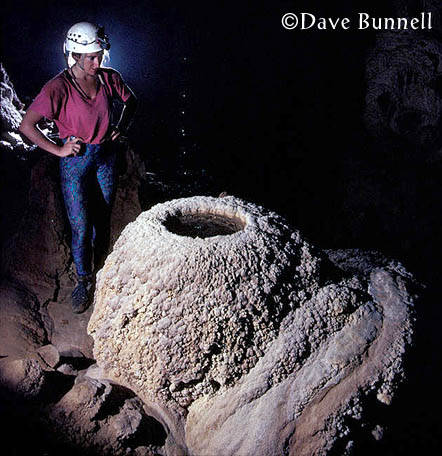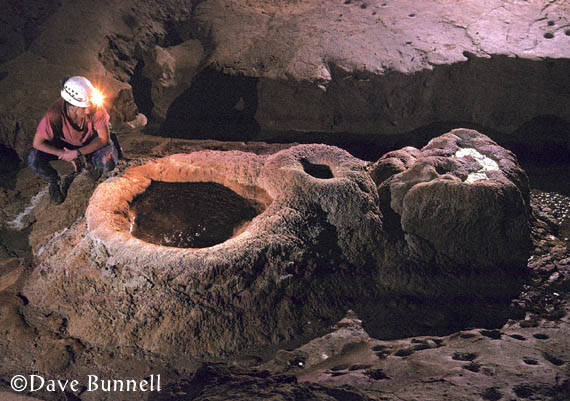
| "Bathtubs" are unusual
speleothems thus far known from only a few caves. The ones here are from
Snail Shell Cave, in the Gunung Mulu region of Borneo. Though taller specimens
grade into the more typical form of a stalagmite,
such as the "kitchen sink" variety in the upper photo, the broad, squat
grouping of the lower photo bears the undeniable aspect of a genuine bathtub.
Both of the specimens shown below are fed by seeps, as you might infer by the falling water droplets in the upper photo and rippled pool surface in the lower. On any particular day, one may find these seeps either rapidly dripping or perhaps gushing with steady streams. The seep discharge seems to depend on whether it's merely raining at the moment, or if there's a serious tropical downpour. The pH of the seep water likewise fluctuates widely. On a drier day the seeps run somewhat acidic, but on a wetter day, they are unusually alkaline. Such schizophrenic water chemistry likely has something to do with the form of bathtubs, which seem as if they can't make up their mind whether they're being built up or eaten away. The temporal variations in the seep chemistry at Snail Shell Cave may be analogous to similar spatial variations recognized in many caves. It is not uncommon to find deep shafts carved by corrosive waters occurring side-by-side with banks of speleothems deposited by supersaturated waters. This striking variation in neighboring waters is attributed to differences in overlying plumbing. If waters are conducted to the cave along open, gas-filled fissures, (in an "open-system") soil-derived carbon dioxide is continuously absorbed by the water en route. This water may thus carry some unreacted carbonic acid as it enters the cave, and so dissolve limestone or speleothems. If, however, water completely fills its infeeder conduit (in a "closed system"), carbon dioxide is not available to the solution beyond the soil zone. The initial carbon dioxide will react completely with the conduit bedrock and most certainly arrive at the cave atmosphere supersaturated, and ready to deposit speleothems. It is clear that the conduits feeding "bathtubs" are generously proportioned, as they consistently allow rapid through-flow of surface water. During "dryspells" the conduits are not filled to capacity, and soil carbon dioxide is most likely drawn downward into their depths, allowing open system dissolution within the conduit, and discharge of an acidic solution at the cave seep. During heavy storms, however, the conduits may be fully inundated by rainwater. The alkaline waters reaching the cave at these times are consistent with closed system dissolution, in which the overlying plumbing is filled to capacity. The seeps overlying the bathtubs in the lower photo are, themselves, depositing unusal ceiling features that are found in many caves in the Mulu region. An example of these "showerheads" may be seen in another alcove of the Virtual Cave. |
![]()

 |
Tune your dial to KTUB and hear these bathtubs in action! (118 kb .wav file) Even on a dry day, they're quite lively! |

![]()
| Back to: | |
 |
Created: November 19, 1995 Last Updated: January 16, 1996 Author: Djuna Bewley |